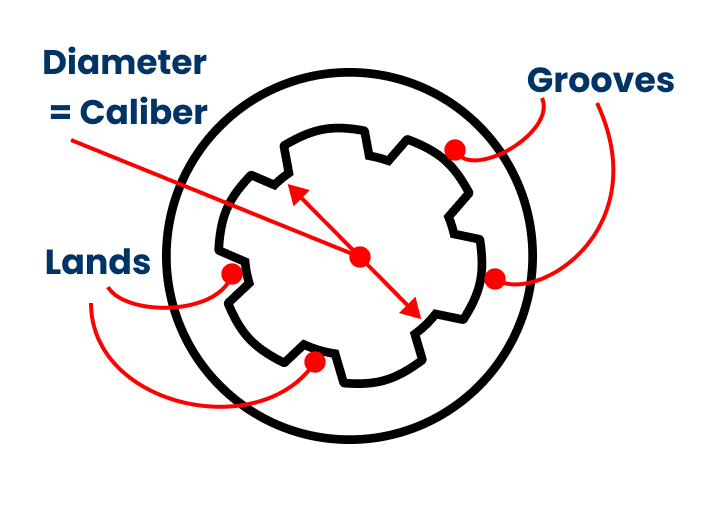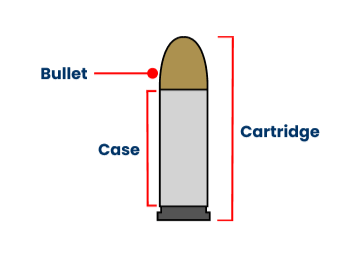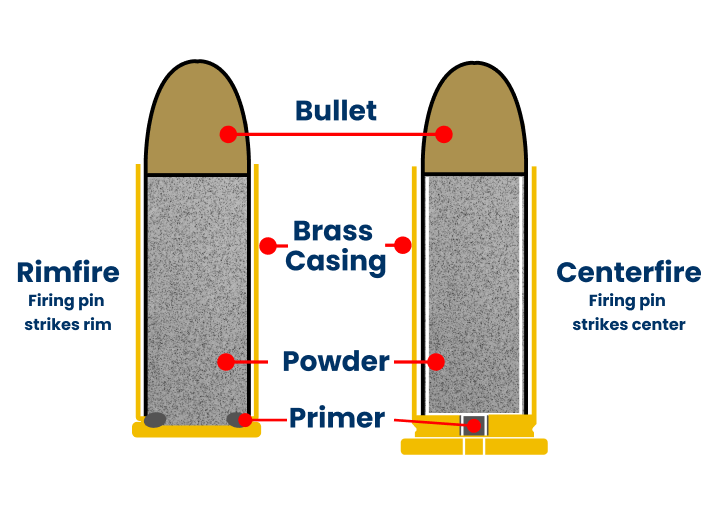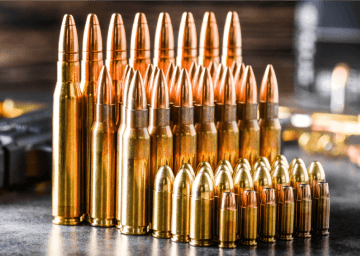What are the Types of Ammunition? FMJ, Hollow Point, and More

From the sleek precision of handgun ammo to the big impact of buckshot, the ammunition world is diverse. Understanding the various types of ammunition is crucial for operating your firearm safely and proficiently. In this article, we’ll explore the different types of ammunition, their characteristics, and their uses.
Key Takeaways
- Caliber: Caliber refers to the diameter of the gun barrel. Shooters should select the appropriate caliber for their specific needs, whether for hunting, self-defense, or competitive shooting, to ensure effectiveness and safety.
- Bullet vs Cartridge: The bullet is the projectile, while the cartridge is the entire package that includes the bullet, gunpowder, casing, and primer.
- Bullet Types: Full metal jackets, hollow points, and soft points are designed for specific purposes, ranging from target shooting to hunting and self-defense.
- Rimfire vs Centerfire: The primary distinction between rimfire and centerfire ammunition lies in the ignition system, which affects the reliability, range, and application.
- Ammo for Each Firearm: Different types of ammunition including rifle, handgun, birdshot, buckshot, and slug, are tailored for specific firearms and shooting purposes, from precision long-distance shooting to hunting and self-defense.
Caliber

Although it’s common speech to refer to ‘caliber’ as the width of the round or bullet, technically the caliber is the diameter of the gun barrel. A higher caliber means a bigger round. Depending on the manufacturer, this measurement can be in inches (e.g., .45 caliber) or millimeters (e.g., 9mm).
Bullet vs Cartridge

When talking about guns, the term ‘bullet’ describes the metal projectile inside the round’s casing that is propelled toward the target. The weight of bullets is measured in grains, with one grain equaling 1/7000th of a pound. The complete unit that houses the bullet, casing, powder, and primer is known as a cartridge.
Materials
Cartridges or rounds are made of many different materials, each with unique performance characteristics. The material you choose depends on your firearm and its intended use.
Steel-cased ammo is commonly used by law enforcement and the military because it can penetrate armor. Due to its high density and hardness, it can maintain its shape even upon impact with hard surfaces. Some areas have restrictions against citizens using steel bullets due to concerns about over-penetration, which could put other nearby individuals in danger.
Brass-cased ammo is popular because it is corrosion-resistant and readily available in most gun and ammunition stores. Often used in handgun and rifle ammunition, brass casings are reloadable, making them cost-effective over time.
In recent years, advancements in polymer technology have led to the development of non-metallic bullets. These bullets are lightweight, inexpensive, and reduce ricochet. Polymer bullets are not widely used because they cannot penetrate targets as well as metal materials.
Bullet Types
Now that you understand bullet basics, it’s time to talk about the various types of bullets that are available on the market. Bullets serve different purposes. Learn more about some of the most popular types of bullets below.
Full Metal Jacket
Full metal jackets feature a soft core within a harder metal shell. This shell prevents deformation and enables deeper penetration. The hard casing of FMJ bullets also minimizes the deposit of materials into the barrel, contributing to a cleaner shooting experience.
The FMJ design ensures smooth feeding into the chamber from the magazine, making them a preferred choice for semi-automatic firearms. Full metal jackets are favored for target shooting and competitions due to their reliability and performance.

Hollow Point
Hollow points feature a cavity in the tip of the bullet that causes it to expand upon impact. This feature increases the bullet’s diameter and stopping power. HP bullets transfer all their kinetic energy to the target to ensure maximum impact and reduce the risk of collateral damage.
Hollow points are favored for self-defense because they reduce the likelihood of the bullet passing through the target and posing a danger to unintended objects.

Soft Point
Soft point bullets are versatile. Due to their expansion and penetration balance, they are suitable for hunting large and small game. They offer more expansion than full metal jackets but better penetration than hollow points, striking a balance between impact and depth.
In regions where hollow points are restricted, soft points provide a close alternative in terms of performance. Their smoother, softer tip makes them safe for use in lever-action rifles with tubular magazines. Soft points offer a solution for various shooting needs, from hunting to certain target shooting scenarios where regulations permit.

Rimfire vs Centerfire

Ammunition is typically rimfire or centerfire. Both types have pros and cons. For example, rimfire ammo has less recoil and is perfect for teaching beginners how to shoot. On the other hand, centerfire is more reliable and offers experienced shooters better performance.
The production of rimfire ammo involves adding the primer compound to the inside of the hollow rim of the cartridge case, and then adding the propellant and bullet. Centerfire ammunition, however, is made by putting the primer in a center cavity at the base of the cartridge, which is then filled with propellant and capped with a bullet.
When firing rimfire cartridges, the firing pin hits the cartridge rim, compressing the primer compound to ignite the propellant. The firing pin strikes the primer within a metallic disk at the base of the centerfire cartridge, initiating ignition.
Spent rimfire cartridges can be recognized by a pinch mark on the rim, which shows where the firing pin struck. Alternatively, centerfire cartridges show a mark in the center where the primer was hit.
Centerfire ammunition is available in a broader range of calibers and is designed for various uses, from home defense to big game hunting and precision shooting.
Rimfire ammunition is often used for target shooting and small game hunting due to its more straightforward construction and lower cost. However, it is typically only available for .22 caliber guns, meaning it’s not well-suited for self-defense or large game hunting.
Common Calibers Compared
When determining whether to purchase a certain caliber of gun or cartridge, it is helpful to look at a comparison between popular types. Take a look at this chart to compare several common calibers.
| Common Calibers Compared | ||||
|---|---|---|---|---|
| Caliber | Type | Usage | Velocity (approx.) | Muzzle Energy (approx.) |
|
.22LR |
Rimfire |
Target shooting, small game hunting |
1,200-1,500 fps |
103-118 ft-lbs |
|
9mm |
Centerfire |
Self-defense, law enforcement, military |
1,200-1,400 fps |
369-443 ft-lbs |
|
.45 ACP |
Centerfire |
Self-defense, target shooting |
700-1,000 fps |
295-369 ft-lbs |
|
5.56 NATO |
Centerfire |
Military, law enforcement, target shooting |
2,900-3,200 fps |
959-1,254 ft-lbs |
|
.308 Winchester |
Centerfire |
Large game hunting, long-range shooting, military |
2,600-2,800 fps |
2,581-2,729 ft-lbs |
|
.380 ACP |
Centerfire |
Self-defense, close-range shooting |
1,000 fps |
192-216 ft-lbs |
|
10mm |
Centerfire |
Self-defense, medium game hunting, large game hunting, law enforcement |
1,000-1,300 fps |
600-760 ft-lbs |
|
5.7 FN |
Centerfire |
Self-defense, law enforcement, military |
2,250-2,800 fps |
220-400 ft-lbs |
|
.38 SPL |
Centerfire |
Self-defense, target shooting, target competition, small game hunting |
710-1,174 fps |
165-290 ft-lbs |
|
.357 MAG |
Centerfire |
Self-defense, medium to large game hunting, target shooting |
1,700-2,200 fps |
225-800 ft-lbs |
Ammo for Each Firearm
Various types of ammunition are tailored for specific firearms and shooting purposes, from precision long-distance shooting to hunting and self-defense. Learn more details about the different kinds of ammo below.
Rifle
Rifles fire ammunition with a single projectile designed for precision and long-distance shooting, often used in hunting and sports shooting.
- Full Metal Jacket (FMJ): Ideal for target shooting and competitions because of its reliability and performance.
- Soft Point (SP): Offers a balance between expansion and penetration, making it suitable for hunting both large and small game.
- Hollow Point (HP): Provides expansion upon impact, increasing stopping power, suitable for hunting and tactical use.
- Ballistic Tip: Combines FMJ accuracy with hollow point expansion using a rubber ball to prevent tip plugging. Suitable for law enforcement and self-defense scenarios.
Rifles come in various calibers and configurations to suit different needs, from varmint hunting to long-range target competition.
Shotgun

Shotgun ammunition offers versatility with different types of shells for hunting, sport shooting, and home defense. The types of ammo used for shotguns include birdshot, buckshot, and slugs:
- Birdshot: Contains small pellets designed to spread over a
wide area. This makes it ideal for hunting birds and small game without
causing excessive damage. The spread of birdshot increases the chance of
striking a moving target in flight, making it a preferred choice among bird
hunters.
#7 and #8 shot are ideal for clay target shooting and small birds such as quail. #5 and #6 shot are larger pellets suitable for pheasants and medium-sized birds.
- Buckshot: This cartridge is packed with larger pellets or
BBs perfect for hunting larger game, making it suitable for deer hunting.
The size and number of pellets in buckshot vary, allowing users to choose
the optimal balance between range and stopping power.
#4 buck is smaller with pellets suitable for medium-sized game or deer at closer ranges. #00 buck (double-aught) ammo is commonly used for deer hunting and home defense due to its effective range and stopping power, but be wary of overpenetration as it can go through walls.
- Slugs: A single, large projectile fired
from a shotgun
shell. They provide rifle-like precision and significant stopping
power at closer ranges. Slugs are effective for hunting larger game where
precision is crucial and are also used in law enforcement to breach
obstacles.
Primary uses include bird hunting, deer hunting, home defense, competitive shooting, and tactical applications.
Pistol
Pistols are popular due to their adaptability. They accommodate various ammunition types.
- Full Metal Jacket (FMJ): Excellent for training and competitive shooting due to its reliability and accuracy.
- Hollow Point (HP): Preferred for self-defense, expanding on impact to maximize stopping power and minimize risk.
Primary uses for pistols include self-defense, competitive shooting, and law enforcement.
Revolver
Revolvers are known for their reliability and ease of use, making them an option for self-defense and hunting.
- Full Metal Jacket (FMJ): Used for training and competitive shooting due to its reliability and accuracy.
- Lead Round Nose (LRN): Often used for target practice due to its affordability, but not meant for hunting.
- Hollow Point (HP): Offers controlled expansion for significant stopping power, ideal for self-defense and hunting.
- Wadcutter (WC): Produces clean holes in paper targets, ideal for precise scoring in target shooting.
Primary uses for revolvers include self-defense, target shooting, and hunting small to medium game.
How to Choose Your Ammo

When choosing ammunition, start by considering your firearm’s intended use: target shooting, hunting, self-defense, or competition. Each activity requires a different type of ammunition — for example, hollow points for self-defense or full metal jacket rounds for target shooting.
Next, familiarize yourself with your firearm’s specifications and manufacturer recommendations. Pay attention to factors such as caliber, bullet grain, and maximum pressure levels to ensure your chosen ammunition is compatible with your gun.
Lastly, consider your personal preferences regarding factors like recoil and cost. To safely and effectively fire ammunition, you have to be comfortable using it. You can experiment with different types and brands of ammunition at the shooting range to help you determine what feels right for you.
Have Fun Out There!
Ready to stock up on ammo? Visit Academy Sports + Outdoors today to explore a wide selection of ammunition for every purpose, from hunting to competitive shooting and self-defense. Don't compromise on quality and performance — choose Academy for all your ammunition needs.


